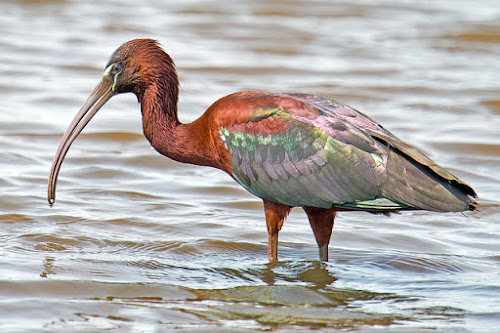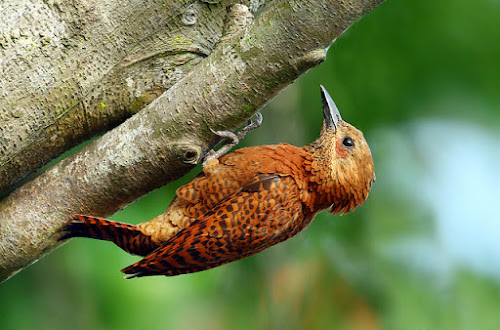1. Rufous Hummingbird
photo link
Described as one of the feistiest hummingbirds in North America, the Rufous hummingbird (Selasphorus rufus) is a fairly small hummingbird with short wings, and a slender, straight, black bill. Also known for their extraordinary flight skills, the species measures about 8–9 cm (3.2–3.7 in) long. Adult males are easily recognized by its bright Rufous (reddish-brown) overall with white breast and ear patch, vivid iridescent-red throat, and green shoulders. Females are green above, white belly and Rufous flanks.
2. Glossy Ibis
photo link
The Glossy ibis (Plegadis falcinellus) is a medium-sized wading bird averaging around 59.4 cm (23.4 in) with an 80–105 cm (31–41 in) wingspan. It is a striking bird with iridescent bronze and Rufous (red-brown overall) plumage, and shiny bottle-green wings and tail. It has a strongly down-curved bill and long black legs. The glossy ibis is widely distributed throughout most warm temperate and tropical regions of the world.
3. Ruddy Quail-Dove
photo link
The Ruddy quail-dove (Geotrygon montana) is a medium-sized dove widespread in the tropical Americas. The species measures around 19–28 cm in length. The bird is distinguished by having Rufous overall with rust colored back, pale buff throat, streak under eye, and belly. Black tipped red bill, red legs and feet.
4. Rufous Motmot
photo link
The Rufous motmot (Baryphthengus martii) is a large near-passerine bird measuring 46 cm (18 in) long and weighs 195 g (6.9 oz). It is the second largest and arguably the most spectacular of the motmots. The species is a resident breeder in rain forests from northeastern Honduras south to western Ecuador, northeastern Bolivia, and southwestern Brazil. It is mainly cinnamon-rufous, with a black face mask and iridescent patches of turquoise blue on its head. It has a greenish-blue underparts, green wings and flanks, and dark blue tail and flight feathers.
5. Chestnut Munia
photo link
The Chestnut munia (Lonchura atricapilla), also known as Chestnut Muni, is a small Rufous (red-brown) finch found in Bangladesh, Brunei, Cambodia, China, India, Indonesia, Laos, Malaysia, Burma, Nepal, Philippines, Singapore, Taiwan, Thailand and Vietnam. It is easily identified by the black head, Rufous (red-brown) body, light grey beak, and blue-gray eyering. This passerine bird averages 11–12 cm in length. Both sexes look alike - but only the male sings. Before 1995, it was the national bird of the Philippines, where it is known as mayang pula ("red maya").
6. Nankeen Night Heron
photo link
The Nankeen night heron (Nycticorax caledonicus), also known as Rufous Night-Heron, is a medium, stocky heron found in Indonesia, the Philippines, Papua New Guinea, Melanesia, and throughout much of Australia. The striking bird measures around 55–65 cm and weighs 550–1014 g. It is a thick-necked heron, with a stooped appearance. It has reddish-brown upperparts, white-buff underparts, a black crown and bill, as well as yellow legs and feet.
7. Ferruginous Hawk
photo link
The Ferruginous hawk (Buteo regalis) is the largest of the North American Buteos. This species is a large, broad-winged hawk with white head, streaked, Rufous-red shoulders and back; pale rust, gray, or white tail and feathered legs. Adults measure from 51 to 69 cm (20 to 27 in) and weigh around 977–2074 g (34.5–73.2 oz).
8. Orchard Oriole
photo link
The Orchard oriole (Icterus spurius) is the smallest North American orioles. The species averages 16 cm (6.3 in) long and weighs 20 g (0.71 oz). Adult males are black above and rich reddish-chestnut below. It has a black rounded head and throat; short, squared-off tail, and a straight, sharply pointed bill.
9. Philippine Eagle-Owl
photo link
The Philippine eagle-owl (Bubo philippensis) is a vulnerable owl species endemic to the Philippines. It is one of the largest owls in the world, with an impressive wingspan of around 120 centimetres. Full grown averages 40–50 cm (16–20 in) in length. The plumage is predominantly Rufous coloured, Rufous-buff facial disc, tawny-Rufous crown, small ear-tufts and huge yellow eyes.
10. Rufous Woodpecker
photo link
The Rufous woodpecker, (Micropternus brachyurus) is a reddish brown woodpecker found in South Asia. It is a medium-sized bird with a short crest, slightly curved black bill and reddish eye. Adults average 21–25 cm (8.3–9.8 in) long and weigh between 55–114 g (1.9–4.0 oz).



























































